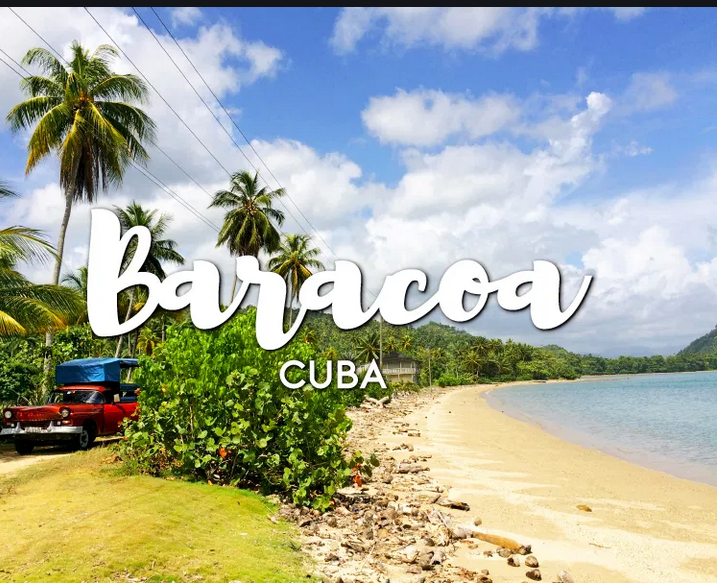Close to the eastern tip of the island and closer to Haiti than Havana, it was founded in 1511 as the first villa in Cuba. It was the first capital of Cuba but fell into oblivion over time as the rest of the villas were founded, as it could only be reached by sea. La Farola Road, one of the seven wonders of 20th century Cuban architecture, was built in the 1970s to provide access to the city.
Baracoa is a true natural paradise, with 29 rivers, the Atlantic Ocean in the north, great mountains in the
south. If you were ever looking for El Dorado, this is the place! And as if the sights weren’t impressive enough, it’s also a true culinary paradise with fantastic seafood, unique dishes, delicious cocoa, and the freshest coconuts around.

Fertile forests, azure seas, tapping music, and delicious desserts-don’t miss the quirky eastern city of Baracoa.
Baracoa has beautiful beaches, far from the crowds and noise found in the big resorts on the northern beaches. The clear sea of Playa Maguana and its bright colors are unmatched in the region. The smooth waves rock you, and it is a great pleasure to float on these waters, protected from sea currents by a series of rocks and coral reefs. El Manglito epitomizes the laid-back Caribbean beach. Soak up the good vibes under the sun and palm trees, stroll along the light-colored sand and bathe in the shallow water, sip a mojito or a beer and enjoy a delicious lunch of fresh fish or seafood right by the sea. Or go swimming at Playa Blanca near the idyllic fishing village of Boca de Miel. Here, a rustic bridge over the Rio de Miel is the perfect place to take a photo before heading to the caves.
Baracoa’s most impressive museum, La Cueva del Paraíso, is a series of caves that were once Taíno burial chambers. Among the nearly 2,000 authentic Taíno artifacts are excavated skeletons, ceramics, 3,000-year-old petroglyphs and a replica of the Ídolo de Tabaco, a statue found in Maisí in 1903 and considered one of the essential Taíno finds in the Caribbean.
One of the most fun things to do in Baracoa off the beaten path is to visit Parque Natural Majayara southeast. During your hike, you’ll come to the home of the Fuentes family, who sell fruit and coffee fresh from their Finca. A little further is a cave, Cueva de Aguas, a cave with a sparkling freshwater pool. If you walk back up the hill, you’ll come to an archaeological trail with more caves and a beautiful view of the ocean.
If you feel like hiking, visit El Yunque, the table-shaped mountain that towers over the village of Baracoa. Although the mountain is only 575 meters above sea level, it is a tiring hike to reach the top. Prepare yourself for hard work, a lot of sweat, and beautiful views of the tropical rainforest. After an intense sun-drenched hike, there is nothing more rewarding than a refreshing dip in the river while you are looking up at a beautiful waterfall. Or go in search of Salto Fino, the highest waterfall in the Caribbean in the Alejandro de Humboldt National Park, a UNESCO World Heritage Site.

When you’re done admiring nature, take a look at the trio of muscular Spanish forts that protected Baracoa. Fuerte La Punta, built-in 1803, now houses a fantastic restaurant. Fuerte Matachín, built-in 1802, which now houses the Museo Municipal. The small but beautiful building exhibits a fascinating chronology of Baracoa, including polymita snail shells, the story of Che Guevara and the chocolate factory, and the particular musical movement that Baracoa produced: the kiribá, an ancestor of the son. Alternatively, you can go to Castillo de Seboruco. Baracoa’s tallest fort, now barely recognizable as a fort, serves as Hotel El Castillo.
For a different kind of museum, you can visit Casa del Cacao. It displays elements of history related to cocoa cultivation in the region and the history of Mayan culture. The museum also explains handling the grains, drying in the sun in large drawers, and finally, roasting on a wood fire in unique pots, cleaning, and grinding. And if you still have a chocolate craving, a chocolate factory produces chocolate bars and other treats for sale.
For a small town, Baracoa certainly has a lot to offer! If you thought that only your days here would be jam-packed, you are wrong!
The nightlife is amazing in Baracoa with live music and different styles of rhythms. You can’t go wrong. Whether you visit Casa de la Trova, Cuba’s smallest, wildest, and most atmospheric place, or Casa de la Cultura, make sure you grab a mojito and put on your dancing shoes because you’ll be dancing in no time!

Leave a Reply
You must be logged in to post a comment.